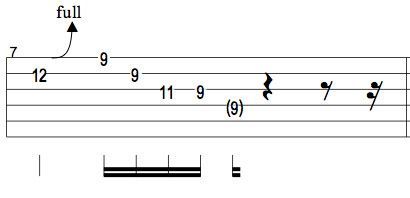The Best Stevie Ray Vaughan Blues Guitar Techniques And Licks
By Antony Reynaert
I remember when I began playing the guitar, I started playing songs from my favorite rock bands like Metallica, Nirvana and Blink 182. After a while I turned away from playing those songs because I wanted to be able to improvise freely on my guitar. Around that time is when I started getting into blues guitar. I remember one night when I was watching a Stevie Ray Vaughan Youtube video that I said to myself ‘Man, I want to be able to learn to play the guitar just like he does.’ Fortunately, a few months later, I got in touch with a wonderful blues guitar teacher who taught me all about Stevie Ray Vaughan and his playing style. In this article I want to share what I have learned throughout the years.
First let’s look at some aspects of SRV’s playing that make his style so unique. In the next video you can see me play with Stevie Ray Vaughan his left hand muting technique, which makes it possible to hit the strings really hard (I'll give you some insight and exercises further in the article):
Stevie Ray Vaughan's Great Dynamics And Feeling
Blues originates from poor people that had nothing to lose so that is the reason why there’s a large amount of aggression and sexuality in this musical style. In case you like to play blues guitar, but you lack that ‘spark’, I recommend you to observe how Stevie Ray Vaughan approaches dynamics in his guitar playing. Check out if you can strike the strings with the same amount of aggression as he does, then try to pick as lightly as you can. In blues guitar playing, dynamics are of paramount importance. When you approach every note with an equal volume level, then it might happen that you do not sound as interesting as you want to.
No one says that you have to imitate SRV’s raw force of feeling and in according to me, nobody is asking for another SRV imitation, but this style is so interesting that you’re going to find a lot of advantages just exploring it and using parts of it in your own playing.
SRV’s Unique Guitar Tone
Basically, most of the SRV-tone involves playing with a hard grip. Don’t go easy on your fingers, hold the strings down hard. It’s the same story for your right hand, occasionally you have to pick quite softly, but in my experience I noted that many intermediate players play softly. So one should train gripping the guitar and smashing the strings (of course while using a proper left-hand muting technique, which is a technique I am going to talk about as well in this article, to prevent undesired string noise). Regarding equipment, you can utilize any Fender tube-amp to plug your stratocaster into. Concerning overdriven sounds, I recommend a tube screamer pedal, for example the Boss Bluesdriver. Especially when talking about Stevie Ray Vaughan, the saying ‘Tone is in your fingers’ can not be more true.
Learn The Main Guitar Techniques Of Stevie Ray Vaughan
SRV String Bending
One of Stevie Ray Vaughan’s main inspirations was blues guitarist and singer Albert King.
It definitely pays off to learn a few Albert King techniques and licks before we delve into SRV’s style. Below you can see an illustration: check out the bending technique in this particular lick.

Listen to what this lick sounds like.
Vibrato Combined With Bending
A lot of what marks Stevie Ray Vaughan’s characteristic style is the raw feeling he puts into each and every one of the notes. He is great at pouring as much emotion as he can into every single note. In a second, we are going to discuss how you can integrate this attitude into your own playing style, but for now we shall check out this very evocative vibrato technique.

Bend the string up with your ring, middle and index fingers in order to have more control over the string. From the moment the bend has reached its target note (i.e. the E-note for this example), perform a medium-width vibrato while still bending up to the target note. While performing the vibrato, keep on hitting the string multiple times. If you train that technique for a while you should be able to make your guitar weep like a little schoolgirl.
You can see me play this technique in the how to make your guitar cry video.
Classic Stevie Ray Vaughan Licks To Add To Your Trick Book

Listen to what the lick sounds like.
The lick in the tablature above, which is derived from the Am pentatonic scale, is an ideal starting point for making your way to look into some signature SRV-licks. I purposely left out the rhythm indication because there are so many different ‘feels’ to approach this lick with. Stevie generally used ‘rubato’, also called ‘floating rhythm’, in his playing so I advise you to listen closely to his records in order to capture his rhythmic approach. The Bb-note on the 1st string on the 6th fret is utilized as an out-of-key passing tone, which adds a nice embellishment to the lick. You can also see the blue-note in this lick. It is on the 3rd string on the 8th fret.
SRV is famous for his extended licks with a large amount of notes. The most common way in which this is done is by expanding licks diagonally across the fretboard. In this 2nd lick you’ll see the first lick in the first part. However, we added an extension on the lower strings to the 1st lick in order to create a typical SRV extended lick.

Listen to what the lick sounds like.
Get That Real SRV Tone With The Left Hand Muting Technique
SRV’s legendary energetic sound is incredibly unique, so we’ll discuss this below. If you want to play with aggressiveness in your playing, you should develop a very decent left hand muting technique. If you only play one note with the highest volume level you can achieve and add all the vibrato in the world to it, you would still never sound as energetic as when SRV would do it. In case you like to come closer to his type of energy and hit the string very hard, you will have to practice the left hand muting technique.

Take the D-note in the example above for example. If you only hit the G-string you lose the potential power of hitting all the strings. On the right you’ll see this same note but in this measure with all the other strings are muted. You hit all the strings, but only the G-string ring out while all the other strings won’t. Mute the three low strings (i.e. the E, A and D string) with your thumb and mute the 1st two strings (i.e. the high E and B string) with the front of the fingers that press down on the strings. It requires quite some practice to cleanly mute all of the strings, but here are some exercises to help you get past the initial stages.



Do you feel like you lack conviction, power and emotion when you are playing blues guitar solos? Check out my free downloadable guide on how to play guitar with feeling.
Are You Struggling To Get Your Blues Guitar Playing To The Next Level? Start Here With The Essential Blues Guitar Soloing Lesson.
